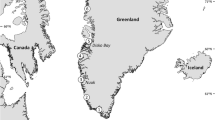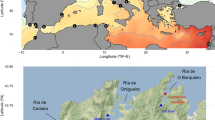Summary
The reproductive effort of the limpet, Cellana tramoserica was investigated in high, mid, and low intertidal areas of the rocky shore as well as in a subtidal population. The reproductive effort of individuals within a population was independent of age. There was, however, a noticeable difference among populations with respect to the relative amount of gonad material spawned per year. The individuals from the subtidal population had the greatest reproductive effort, spawning the equivalent of 101% of their somatic weight per year, while the low, mid and high intertidal populations spawned the equivalent of 66%, 20%, 51%, respectively.
Experimental transplants showed that individuals from all three intertidal populations increased their reproductive effort to match that of subtidal individuals. It was unlikely, therefore, that the observed patterns were the result of genetic differences among the populations. The reproductive effort of the populations was also not correlated with the rate of mortality of the adults in the four populations. The observed differences could be explained by a combination of the availability of food and intraspecific competition. The flexibility in the reproductive pattern of Cellana is hypothesised to be a result of this species having a dispersive larval stage, which may result in selection for plasticity of reproductive allocation, depending upon the environmental conditions at the site of settlement and growth to adult size.
Similar content being viewed by others
References
Anderson DT (1962) The reproduction and early life history of the gastropods Bembicium auratum (Quoy and Gaimard) (Family Littorinidae), Cellana tramoserica (Sower.) (Family Patellidae) and Melanerita melanotragus (Smith) (Family Neritidae). Proc Linn Soc NSW 87:62–68
Bernard FR (1977) Fishery and reproductive cycle of the red sea urchin, Strongylocentrotus fransiscanus, in British Columbia. J Fish Res Bd Can 34:604–610
Beverton RJH, Holt SJ (1957) On the dynamics of exploited fish populations. Fishery Investigation Ser II. Vol XIX. London: Her Majesties Stationary office
Branch GM (1974) The ecology of Patella (L.) from the Cape Peninsula, South Africa. 2 Reproductive cycles. Trans roy Soc S Afr 41:112–160
Charnov EL, Krebs JR (1973) On clutch size and fitness. Ibis 116:217–219
Charnov EL, Schaffer WM (1973) Life-history consequences of natural selection: Coles' results revisited. Am Nat 107:791–793
Cody M (1966) A general theory of clutch size. Evolution 20:174–184
Creese RG (1980) The reproductive cycles and fecundities of four common eastern Australian archeogastropod limpets (Mollusca: Gastropoda). Aust J mar Freshwat Res 31:49–59
Creese RG, Underwood AJ (1982) Analysis of inter- and intraspecific competition amongst intertidal limpets with different methods of feeding. Oecologia (Berlin) 53:337–346
Crisp DJ (1974)a Energy relations of marine invertebrate larvae. Thalassia Jugoslavica 10:103–120
Crisp DJ (1974b) Factors influencing the settlement of marine invertebrate larvae. In: “Chemoreception in marine organisms” (PT Grant and AN Mackie, eds) pp 177–265. Academic Press Lond, NY
Ebert TA (1973) Estimating growth and mortality from growth and size data. Oecologia (Berlin) 11:281–298
Ernest RG, Blake NJ (1981) Reproductive patterns within subpopulations of Lytechinus variegatus (Lamark) (Echinodermata: Echinoida). J exp mar Biol Ecol 55:25–38
Fisher RA (1930) The genetical theory of natural selection (Dover press, New York) rev ed 1958
Fletcher WJ (1984) Intraspecific variation in the population dynamics and growth of the limpet Cellana tramoserica. (submitted manuscript)
Fuji A (1960) Studies on the biology of two sea-urchins Strongylocentrotus nudus and S. intermedius, in Southern Hakkaido. Bull Fac Fish Hakkaido Univ 11:47–49
Gadgil M, Bossert WH (1970) Life history consequences of natural selection. Am Nat 104:1–24
Gonor JJ (1973) Reproductive cycles in Oregon populations of the echinoid Strongylocentrotus purpuratus (Stimpson). I Annual gonad growth and ovarian gametogenic cycles. J exp mar Biol Ecol 12:45–64
Gotto RV (1962) Egg number and ecology of commensal and parasitic copepods. Ann Mag Nat Hist, 135 (5):97–107
Harper JL, Ogden J (1970) The reproductive strategy of higher plants. I The concept of strategy with special reference to Senecio vulgaris L. J Ecol 58:681–698
Hickman JC (1975) Environmental unpredictability and plastic energy allocation strategies in the annual, Polygonum cascadense (Polygonaceae). J Ecol 63:689–701
Hirshfield MF, Tinkle DW (1975) Natural selection and the evolution of reproductive effort. Proc natn Acad Sci USA 72:2227–2231
Kaplan SM, Salthe SN (1979) The allometry of reproduction: an empirical view on salamanders. Am Nat 113:671–689
McKillup SC, Butler AJ (1979) Modification of egg production and packaging in response to food availability by Nassarius pauperatus. Oecologia (Berlin) 43:221–233
Murphy G (1968) Patterns in life history and the environment. Am Nat 102:391–404
Murphy PG (1976) Electrophoretic evidence that selection reduces ecological overlap in marine limpets. Nature 261:228–230
Orton JH, Southward AJ, Dodd JM (1956) Studies on the biology of limpets II The breeding of Patella vulgata L. in Britain. J mar biol Ass UK 35:149–176
Parry GD (1982a) The evolution of the life-histories of four species of intertidal limpet. Ecol Monogr 52:65–92
Parry GD (1982b) Reproductive effort in four species of intertidal limpet. Mar Biol 67:267–282
Perrins CM (1965) Population fluctuations and clutch size in the great tit, Parus major L. J anim Ecol 34:601–647
Perron FE (1982) Interspecific and intraspecific patterns of reproductive effort in 4 species of cone shell (Conus spp). Mar Biol 68:161–168
Pianka ER (1970) On r and K selection. Am Nat 104:592–597
Picken GB (1980) The distribution, growth, and reproduction of the Antarctic limpet Nacella concinna (Strebel 1908). J exp mar Biol Ecol 42:71–85
Richards FJ (1959) A flexible growth function for empirical use. J Exp Bot 10:290–300
Schaffer WM (1974) Selection for optimal life histories: effects of age structure. Ecology 55:291–303
Scheltema RS (1971) Larval dispersal as a means of genetic exchange between geographically seperated populations of shallow water benthic marine gastropods. Biol Bull 140:284–322
Scheltema RS (1975) Relationship of larval dispersal, gene flow and natural selection to geographic variation in benthic marine invertebrates in estuaries and along coastal regions. In “Estuarine research” Vol 1 (LE Cronin, ed) 738 pp Acad Press New York, London
Snell TW, Burch DG (1975) The effects of density on resource partitioning in Chamaesyce hirta (Euphorbiacea). Ecology 56:742–746
Spight TM, Emlen J (1976) Clutch size of two marine snails with a changing food supply. Ecology 57:1162–1178
Stearns SC (1976) Life-history tactics: A review of the ideas. Q Rev Biol 51:3–47
Stearns SC (1977) Evolution of life history traits: a critique of the theory and a review of the data. Ann R Ecol Syst 8:145–171
Sutherland JP (1970) Dynamics of high and low populations of the limpet Acmaea scabra (Gould). Ecol Monogr 40:169–188
Thorson G (1950) Reproduction and larval ecology of marine bottom invertebrates. Biol Rev 25:1–45
Tinkle DW, Hadley NF (1975) Lizard reproductive effort: calorific estimates and comments on its evolution. Ecology 56:427–434
Underwood AJ (1974) The reproductive cycles and geographical distributions of some common Eastern Australian prosobranchs (Mollusca: Gastropoda). Aust J Mar Freshw Res 23:63–88
Underwood AJ (1975) Comparative studies on the biology of Nerita atramentosa Reeve, Bembicium nanum (Lamark) and Cellana tramoserica (Sowerby) (Gastropoda: Prosobranchia) in S.E. Australia. J exp mar Biol Ecol 18:153–172
Underwood AJ (1978) An experimental evaluation of competition between three species of intertidal prosobranch gastropods. Oecologia (Berlin) 33:185–202
Underwood AJ (1979) The ecology of intertidal gastropods. Adv Mar Biol 16:111–210
Underwood AJ (1984) The vertical and seasonal abundance of microalgae on a rocky shore in N.S.W. (in preparation)
Williams GC (1966) Adaptations and natural selection: a critique of some current evolutionary thought. Princeton, New Jersey
Author information
Authors and Affiliations
Rights and permissions
About this article
Cite this article
Fletcher, W.J. Variability in the reproductive effort of the limpet, Cellana tramoserica . Oecologia 61, 259–264 (1984). https://doi.org/10.1007/BF00396770
Received:
Issue Date:
DOI: https://doi.org/10.1007/BF00396770




